To Music-folklore Roots. Regional Peculiarities of
Folk Music (Rhythm – Melody – Harmony)
National partners
- University: Masaryk University, Faculty of Education, Department of Music Education
- School: Elementary and Nursery School of J. Hlubik, Lipov. Pupils of 4 – 6th grade
- Ensemble: Petr Galečka’s Dulcimer Band from the Region of Horňácko, Lipov
Potentials
The topic of the Czech team is based on the national music folklore heritage. The folklore song fund in Bohemia, Moravia and Silesia is traditionally the basic methodical source of the Czech institutionalized music education. The variety of songs regional types, their peculiarities in the field of rhythm, melody and harmony enable to stimulate different sides of pupil’s/student’s personality, including music creativity. To promote creative activities in this area, the selected music features of individual songs might help or the function of the song, principles of traditional folk culture, syncretism of folk phenomena etc. might be useful.
- Folk songs reflect the experience, imaginations and desires of a man; they accompany them in various life situations. They offer the opportunities for a wide spectrum of music activities and non-music manifestations.
- Then Czech Music Folklore Fund offers a rich variety of types and variants of songs and instrumental music.
- All parts of folk song melody enable music activities and development of creativity. Rhythmical structure of melody is the basic methodical starting point.
- Further means of stimulating music activity and creativity is a melodic part, tonal character and latent harmony of the folk song melody.
- The variety and variability of song fund enables to learn cultural phenomena in wider connections, to search for parallels or differences – not only within regional music folklore manifestations.
- The principles of folk music might be compared with other music manifestations in artistic and non-artistic area.
Promoting creativity and entrepreneurship in the field of music education and music performance in schools is an important stimulus to pupils’ motivation, initiative, tenacity and responsibility. During music creative activities, they search in the given area for own topics which they reproduce, change, perceive in various connections. They work in groups, individually, they cooperate with the members of the music ensemble, both in lessons of music education and while presenting the results of creative music activities in public. This way of music activities stimulation enables the pupils to deeply understand and experience music, to learn various cultural manifestations. At the same time, their mutual tolerance, respect and ability to work in a team is stimulated.
Structure
The development of topics promoting music activities and creativity by means of folk music is done in cooperation with university students. The main aim is to identify, on the basis of various regional song types, sources for music activities of pupils and development of their interpretational, receptive and creative skills. The important part of methodical procedures is the motivation of pupils for public presentation of their results; pupils are led to be able to develop the original music thought in further process of transformation to the form of artistic performance in public.
Materials
The music material is prepared by university students together with the members of Petr Galečka’s Dulcimer Band from the Horňácko Region. The suggested procedures will be verified by the pupils of 4 – 6th year of the partner elementary school and at the seminars for teachers. The artistic partner (PGDBHR) takes part in creative process of the pupils, cooperates in given mutual topics. It shows the richness and peculiarities of song material, character of instrumental accompaniment in connection with the song types and the region they come from. The members of the ensemble stimulate the interest of the youth in interpretational and listening activities, offer music experience, promote individual thinking and creative activities in pupils while presenting music folklore phenomena in lessons at school, in rehearsals of children folklore ensemble, at a concert or compered performance for pupils. Both groups (pupils and musicians) insert, on the basis of a guided dialogue, their own topics into the programme – on the basis of principles of analogy, contrasts, variations etc.
Applied methods, aims, means:
- sources collecting and their verification
- analysis of music performances, comparison
- activation activities, playful forms, creative manifestations in interpretational and receptive field
- integration processes
- singing, rhythmic, rhythmic-movement, instrumental, dance and musical-dramatic expression, working with a music text
Principles:
- contrast, similarity, variation, connections, inspiration
- reflection, imitation, improvisation, transformation
Download
You can download the concepts in English, German and every partner’s national language: Download (PDF)
